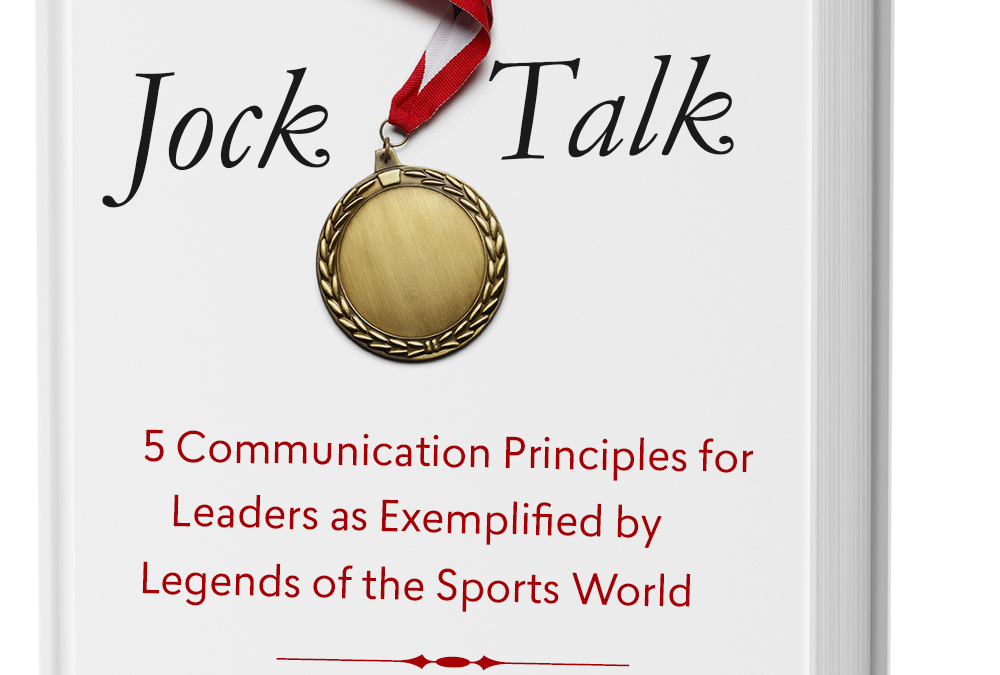by Beth Levine | Aug 5, 2015 | Just Mouthing Off, public speaking, quote
 When Pat Williams @OrlandoMagicPat – a long-time legend in the NBA, most recently as co-founder and SVP of the Orlando Magic – interviewed me about Jock Talk for his radio show on WORL in Orlando, “Inside the Game,” I didn’t know that he too had written a book on public speaking from the vantage point of sports figures.
When Pat Williams @OrlandoMagicPat – a long-time legend in the NBA, most recently as co-founder and SVP of the Orlando Magic – interviewed me about Jock Talk for his radio show on WORL in Orlando, “Inside the Game,” I didn’t know that he too had written a book on public speaking from the vantage point of sports figures.
He told me after the interview that he wanted to send me something. What he sent was his book. As I read through it, I came across a lot of values and concepts he and I held in common.
Because of my work with professional and world-class athletes – and most recently with a medal-winning Olympian – one passage in particular caught my attention:
“There are many retired athletes from various sports who have a lot to offer on the convention and corporate lecture circuit. They could command five-figure speaking fees, but what are they doing? They’re earning a fraction of that, signing autographs at sports memorabilia shows. Nothing wrong with that, but why not take their game to the next level? Why not share the real wisdom that they have to offer? Why not organize their stories and ideas into a presentation that would change lives – including their own?
It’s essentially a matter of organization, planning, and preparation. The only confident, influential speaker is a prepared speaker. Organization and preparation are vital to your success as a communicator.“
Pat has it right. Many retired athletes do miss a great opportunity to tell their story and offer concrete value to corporate audiences.
For any speaker, it can seem daunting to figure out what that value is, but, with a little organization, planning and preparation, it’s definitely doable. Even if you’re not a gold-medal Olympian – but you’re an engineer or a scientist or an entrepreneur – you will still benefit from taking the time and focus to identify your valuable lesson(s) before you speak.
To find your valuable lesson(s), it might help to imagine a Venn diagram: The first circle represents you, your knowledge and expertise, and the second represents your audience and their interests. You have to figure out what’s in the shaded area where the circles intersect. For you, it is an insight or lesson you can offer. For your audience, it is what they want or need. The third circle of the Venn diagram makes it more challenging – it represents what other experts or speakers have to offer.
If you really want to stand out as a speaker, you will spend some time fine-tuning the area of the diagram where you intersect with the audience but other speakers don’t. In other words, given your expertise, what can you talk about that is of interest to your audience that no one else can offer?
For retired athletes, this exercise should be a layup, so to speak. For the rest of us, admittedly it’s more challenging … but it’s well within reach and very worthwhile.
by Beth Levine | Mar 18, 2015 | smartmouth talks!
Brevity.
One really easy and effective technique for keeping yourself on a diet of short and sweet is to think about talking less and engaging more – making your presentations more of a give and take. For example, make a point and then open up the floor for questions or discussion. Besides creating a change in stimulus, this gives you two other advantages: It provides you with feedback on your audience’s level of understanding and buy-in; and it gives you insight into their biases and self-interests, both of which you need to know to achieve your desired outcome. I often encourage clients to use this technique when they’ve been asked to speak for an hour. Knowing full well that an audience can hang in there for maybe 20 minutes at a time, I encourage people to switch it up and take a Q & A break after each topic section of their presentation, rather than saving audience comments and questions for the end.
Another way to enforce brevity on yourself is to be a minimalist in your preparation. By that, I mean limit your written preparation to some simple bullet points. Once you get involved in writing a script for yourself, you become more and more wedded to the actual words you’ve written and the detail you’ve fleshed out in your script. I have found that some people need to start with a full-text script for their preparation and then work their way down to bullet points, once they’re comfortable enough and familiar enough with the direction and content of their talk. That’s great, too.
Ultimately, if you walk into a room with just the bullet points, you’ll be less attached to the beautiful words and sentences you wrote and you’ll be able to be more present with your audience. This is not to say that there aren’t times that call for a full-text script; there may well be. But be aware that a script can shift you and your attention more to delivering what’s on the paper than to connecting with the audience.
[Excerpted from Jock Talk: 5 Communication Principles for Leaders as Exemplified by Legends of the Sports World, http://amzn.to/1vkcxjz]

by Beth Levine | Mar 5, 2015
In The News Forbes.com Communications 3.0: Nuance Is The Key Ingredient- October 2023 5 Things To Think About Before Working With A Coach – March 2023 3 Ways To Supercharge How Impressive You Are On Stage – October 2022 What Media Trainers Can Learn From...
by Beth Levine | Nov 18, 2014 | preparing for a presentation, public speaking
When you get up to talk or take the microphone at an event, it is not, and should not, be all about you—not if you want to be effective, impressive, and memorable, that is. There is an unwritten, unspoken contract with your audience that you, the speaker, will entertain, enlighten, or energize them. Personal stories need to support a point. The time you take needs to be used to deliver something of value. An audience waits for something new, useful, beneficial, or fun. Audiences like to be acknowledged somehow. In order to deliver on any or all of this, you must prepare your remarks with your audience’s experience in mind. That is the essence of being audience-centric.
Audiences all have biases, self-interests, and expectations. They have a very basic “what’s in it for me?” thread running through their subconscious. They want something in exchange for their time and attention. As if that weren’t enough, they also don’t want to work hard. Unless you guide them and tell them where you’re taking them, they won’t make the connections and get there on their own. To make matters slightly more challenging, competition for people’s attention is tougher, and their devices—cell phones, laptops, tablets—are ubiquitous (although the presence of devices can also be a good thing, as increasingly people use them to take notes).
Finally, an audience sizes you up immediately and, within seconds, decides if you are worth their attention and engagement. There are studies showing that this happens in the first eight seconds. Think about that: In the first eight seconds, people decide whether to listen to you or not. This certainly puts some weight on how you open your talk.
All of this adds up to a tall order. It demands that you, the speaker, think about your audience more than just superficially. Your topic and your time allotment may be fixed, but your audience is a variable, and that should guide you in preparing what you deliver and how. The experience you give them will stay with them longer than any words or data you share.
by Beth Levine | Mar 5, 2012 | Just Mouthing Off
So, I just read an article about how harder-to-read fonts promote better recall. Uh oh, I wondered, slides too? Yup, slides too.
Interestingly enough, most of the prevailing wisdom about creating effective PowerPoint presentations suggests that clean and lean fonts, anything sans serif – i.e. no curlycues on the letters – are best. But apparently, less legible fonts make readers concentrate harder and therefore retain better. It seems counterintuitive until you really think about it and realize that readers have to slow down and focus harder with a font that isn’t as easy to skim.
What fascinated me most, though, about the research presented in this article was that they discovered students learn better from a teacher’s or professor’s handwritten scribbles on a “chalkboard” (probably a whiteboard!) than they do from PowerPoint. Yes, this would make sense given the font proposition. And it also supports my long-held theory that drawing or writing on a whiteboard during your presentation allows your audience to be present for, and part of, the creation of your visuals … and therefore promotes stronger reinforcement and stickiness.
No matter what, though, less is always more in the retention department, so feel free to go ahead and use a busier font, or your own handwriting, but keep the number of words and lines as lean and mean as possible!
 When Pat Williams @OrlandoMagicPat – a long-time legend in the NBA, most recently as co-founder and SVP of the Orlando Magic – interviewed me about Jock Talk for his radio show on WORL in Orlando, “Inside the Game,” I didn’t know that he too had written a book on public speaking from the vantage point of sports figures.
When Pat Williams @OrlandoMagicPat – a long-time legend in the NBA, most recently as co-founder and SVP of the Orlando Magic – interviewed me about Jock Talk for his radio show on WORL in Orlando, “Inside the Game,” I didn’t know that he too had written a book on public speaking from the vantage point of sports figures.



